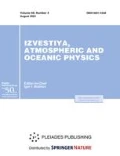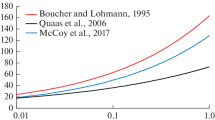Abstract
Improvements in simulations of sulfate aerosol from natural dimethyl sulfide (DMS) emissions in the climate model of the Institute of Numerical Mathematics of the Russian Academy of Sciences (INM RAS) provide a better agreement between new model estimates of aerosol optical thickness (AOT) and the Copernicus Atmosphere Monitoring Service (CAMS) reanalysis data. These data and the latest recommended emissions are used to estimate radiative forcing effects (RFEs) of the sulfate aerosol of different origin at the top of the atmosphere. The maximum (in absolute values) radiative effect of natural sulfate aerosol is observed due to high DMS emissions over the marine coast of Antarctica, where the annual mean RFE is –0.14 W m–2 (up to –0.45 W m–2 in January). For the 25°–45° N area, zonally averaged annual RFEs due to anthropogenic emissions exceed –0.7 W m–2. The average global annual RFE of sulfate aerosol for 2005 is –0.36 W m–2 and hardly changes at all by season. Overall, the fraction of the RFE from natural sulfate aerosol is 20%, but there are significant variations in this value from month to month, with a maximum in January, when this fraction reaches 37%.





Similar content being viewed by others
Change history
28 April 2022
An Erratum to this paper has been published: https://doi.org/10.1134/S0001433822020128
REFERENCES
IPCC: Climate Change 2013: The Physical Science Basis. Contribution of Working Group I to the Fifth Assessment Report of the Intergovernmental Panel on Climate Change, Ed. by T. F. Stocker, D. Qin, G.-K. Plattner, (Cambridge Univ. Press, New York, 2013).
G. Myhre, B. H. Samset, M. Schulz, Y. Balkanski, S. Bauer, T. K. Berntsen, H. Bian, N. Bellouin, M. Chin, T. Diehl, R. C. Easter, J. Feichter, S. J. Ghan, D. Hauglustaine, T. Iversen, S. Kinne, A. Kirkevag, J.‑F. Lamarque, G. Lin, X. Liu, M. T. Lund, G. Luo, X. Ma, T. van Noije, J. E. Penner, P. J. Rasch, A. Ruiz, Ø. Seland, R. B. Skeie, P. Stier, T. Takemura, K. Tsigaridis, P. Wang, Z. Wang, L. Xu, H. Yu, F. Yu, J. -H. Yoon, K. Zhang, H. Zhang, and C. Zhou, “Radiative forcing of the direct aerosol effect from AeroCom Phase II simulations,” Atmos. Chem. Phys. 13, 1853–1877 (2013a).
G. Myhre, C. E. L. Myhre, B. H. Samset, and T. Storelvmo, “Aerosols and their relation to global climate and climate sensitivity,” Nat. Educ. Knowl. 4 (5), 7 (2013b).
O. Boucher, D. Randall, P. Artaxo, C. Bretherton, G. Feingold, P. Forster, V.-M. Kerminen, Y. Kondo, H. Liao, U. Lohmann, P. Rasch, S. K. Satheesh, S. Sherwood, B. Stevens, and X. Y. Zhang, “Clouds and aerosols,” in Climate Change 2013:The Physical Science Basis. Contribution of Working Group I to the Fifth Assessment Report of the Intergovernmental Panel on Climate Change (Cambridge University Press, New York, 2013), pp. 571–659.
A. Rap, C. E. Scott, D. V. Spracklen, N. Bellouin, P. M. Forster, K. S. Carslaw, A. Schmidt, and G. Mann, “Natural aerosol direct and indirect radiative effects,” Geophys. Res. Lett. 40, 3297–3301 (2013).
J. H. Seinfeld and S. N. Pandis, Atmospheric Chemistry and Physics: From Air Pollution to Climate Change (John Wiley and Sons, 2016).
G. Zheng, Y. Wang, R. Wood, et al., “New particle formation in the remote marine boundary layer,” Nat. Commun. 12 (527), 1–10 (2021).
R. M. Hoesly, S. J. Smith, L. Feng, Z. Klimont, G. Janssens-Maenhout, T. Pitkanen, J. J. Seibert, L. Vu, R. J. Andres, R. M. Bolt, T. C. Bond, L. Dawidowski, N. Kholod, J.-I. Kurokawa, M. Li, L. Liu, Z. Lu, M. C. P. Moura, P. R. O’Rourke, and Q. Zhang, “Historical (1750–2014) anthropogenic emissions of reactive gases and aerosols from the Community Emissions Data System (CEDS),” Geosci. Model Dev. 11, 369–408 (2018).
M. O. Andreae, “Ocean–atmosphere interactions in the global biogeochemical sulfur cycle,” Mar. Chem. 30, 1–29 (1990).
M. Chin, R. B. Rood, S.-J. Lin, J.-F. Müller, and A. M. Thompson, “Atmospheric sulfur cycle simulated in the global model GOCART: Model description and global properties,” J. Geophys. Res., Atmos. 105 (D20), 671–24687 (2000a).
M. Chin, D. L. Savoie, B. J. Huebert, A. R. Bandy, D. C. Thornton, T. S. Bates, P. K. Quinn, E. S. Saltzman, and W. J. De Bruyn, “Atmospheric sulfur cycle simulated in the global model GOCART: Comparison with field observations and regional budgets,” J. Geophys. Res., Atmos. 105 (D20), 24689–24712 (2000b).
M. Chin, D. J. Jacob, G. M. Gardner, M. S. Foreman-Fowler, P. A. Spiro, and D. L. Savoie, “A global three-dimensional model of tropospheric sulfate,” J. Geophys. Res.: Atmos. 101 (D13), 18667–18690 (1996).
M. A. Chin and D. J. Jacob, “Anthropogenic and natural contributions to tropospheric sulfate: A global model analysis,” J. Geophys. Res. 101, 18691–18699 (1996).
Y. Yang, H. Wang, S. J. Smith, R. C. Easter, and P. J. Rasch, “Sulfate aerosol in the Arctic: Source attribution and radiative forcing,” J. Geophys. Res.: Atmos. 123, 1899–1918 (2018).
K. S. Carslaw, O. Boucher, D. V. Spracklen, G. W. Mann, J. G. L. Rae, S. Woodward, and M. Kulmala, “A review of natural aerosol interactions and feedbacks within the Earth system,” Atmos. Chem. Phys. 10, 1701–1737 (2010).
E. M. Volodin, E. V. Mortikov, S. V. Kostrykin, V. Ya. Galin, V. N. Lykossov, A. S. Gritsun, N. A. Diansky, A. V. Gusev, N. G. Iakovlev, A. A. Shestakova, and S. V. Emelina, “Simulation of the modern climate using the INM-CM48 climate model,” Russ. J. Numer. Anal. Math. Modell. 33 (6), 367–374 (2018).
E. M. Volodin, N. A. Diansky, and A. V. Gusev, “Simulation and prediction of climate changes in the 19th to 21st centuries with the Institute of Numerical Mathematics, Russian Academy of Sciences, model of the Earth’s climate system,” Izv., Atmos. Ocean. Phys. 49 (4), 347–366 (2013).
E. M. Volodin and S. V. Kostrykin, “The aerosol module in the INM RAS climate model,” Russ. Meteorol. Hydrol. 41 (8), 519–528 (2016).
J. Putaud and C. Nguyen, “Assessment of dimethylsulfide sea–air exchange rate,” J. Geophys. Res. 101 (D2), 4403–4441 (1996).
A. Kettle, M. Andreae, D. Amourou, et al., “A global database of sea surface dimethylsulfide (DMS) measurements and a procedure to predict sea surface DMS as a function of latitude, longitude, and month,” Global Biogeochem. Cycles 13 (2), 399–444 (1999).
J.-J. Morcrette, O. Boucher, L. Jones, D. Salmond, P. Bechtold, A. Beljaars, et al., “Aerosol analysis and forecast in the European Centre for Medium-Range Weather Forecasts Integrated Forecast System: Forward modeling,” J. Geophys. Res. 114, D06206 (2009).
R. W. Gelaro, M. J. McCarty, R. Suárez, A. Todling, L. Molod, L. Takacs, C. A. Randles, et al., “The Modern-Era Retrospective Analysis for Research and Applications, Version 2 (MERRA-2),” J. Clim. 30 (14), 5419–5454 (2017). https://doi.org/10.1175/JCLI-D-16-0758.1
P. Courtier, J. N. Thépaut, and A. Hollingsworth, “A strategy for operational implementation of 4D-Var, using an incremental approach,” Q. J. R. Meteorol. Soc. 120 (519), 1367–1387 (1994).
A. Molod, L. Takacs, M. Suárez, and J. Bacmeister, “Development of the GEOS-5 atmospheric general circulation model: Evolution from MERRA to MERRA2,” Geosci. Model Dev. 8, 1339–1356 (2015).
D. Kleist, D. Parrish, J. Derber, R. Treadon, R. Errico, and R. Yang, “Improving incremental balance in the GSI 3D-VAR analysis system,” Mon. Weather Rev. 137 (3), 1046–1060 (2008). https://doi.org/10.1175/2008MWR2623.1
W.-L. Wang, G. Song, F. Primeau, E. S. Saltzman, T. G. Bell, and J. K. Moore, “Global ocean dimethylsulfide climatology estimated from observations and an artificial neural network,” Biogeosciences 17, 5335–5354 (2020).
L. Goddijn-Murphy, D. K. Woolf, and C. Marandino, “Space-based retrievals of air–sea gas transfer velocities using altimeters: Calibration for dimethylsulfide,” J. Geophys. Res. 117, C08028 (2012).
E. S. Saltzman, D. B. King, K. Holmen, and C. Leck, “Experimental determination of the diffusion coefficient of dimethylsulfide in water,” J. Geophys. Res. 98, 16481–16486 (1993).
Clouds and Cloudy Atmosphere. A Reference Book, Ed. by I. P. Mazin and A. Kh. Khrgian (Gidrometeoizdat, Leningrad, 1989) [in Russian].
U. Lohmann, J. Feichter, C. Chuang, and J. Penner, “Prediction of the number of cloud droplets in the ECHAM GCM,” J. Geophys. Res. 104 (D8), 9169–9198 (1996).
Author information
Authors and Affiliations
Corresponding authors
Additional information
Translated by N. Tret’yakova
Rights and permissions
About this article
Cite this article
Chubarova, N.E., Poliukhov, A.A. & Volodin, E.M. Improving the Calculation of the Sulfate Aerosol Evolution and Radiative Effects in the Institute of Numerical Mathematics, Russian Academy of Sciences, Climate Model. Izv. Atmos. Ocean. Phys. 57, 370–378 (2021). https://doi.org/10.1134/S0001433821040150
Received:
Revised:
Accepted:
Published:
Issue Date:
DOI: https://doi.org/10.1134/S0001433821040150




